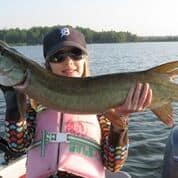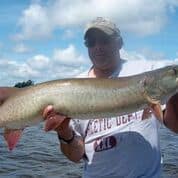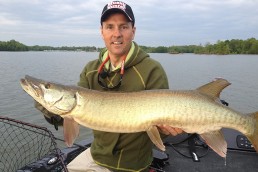June is Transition Time for Michigan Muskies
SHARE THIS POST
Early-season muskies will seek out warmer waters to catch their dinner. However, we also know that a lingering late spring will postpone a muskie’s aggressiveness. But if we search for potential locations and utilize proven strategies for cold-water conditions, we can be successful right out of the gate.
Smaller baits and water temps
When the water temperature is in the lower 50s and 60s, muskie hunters want to keep their lure retrieves on the slow side. However, if you begin your day in the morning, remember that the air temperature may start out in the 40s, but by 3 p.m., water temps will rise. It is at this magical time that the metabolism of muskies will also rise, as it’s “rocket time,” as the muskies turn on the jets.
June is a magical and transitional time for all anglers and the fish they pursue. But for muskie anglers, it is a crucial time to rely on their skills and respond to conditions. In mid-May, when you were on the south side of Lower Michigan, the water warmed faster, usually, than northern Michigan and the U.P. Timing your retrieve stays an important issue this month as you continue to encounter even more warming days.
Lures to use? That is the question. The answer: Let the muskies tell you. Starting out with small bucktails is a good way to cover water quickly. The Mepps line of spinners—usually from a #3 to the #5—and even the Musky Killer is a good choice. No action? It’s not a bad idea to change speeds and jerking moves on something slower and erratic like a 7-inch Suick or an 8-inch Reef Hog. Maybe a follow or two? Okay, let’s throw a thumping, lipless crankbait in bass-size categories, and don’t forget to change the hooks and split rings to something a tad tougher. Remember, you are the magician out there looking for loopholes.
One dynamite spring muskie lure to try in colder water is a bass-sized spinnerbait in white. For some reason this is a good choice in all conditions, including in funky weather, and in clear water or darker, coffee-stained water. Add a White or Black Mogumbo Twister Tail (cut off about 2 inches) and watch your bait all the way into your turn.
Strategies
Starting out your day with unpredictable June weather can be hard on the ego. We were following the early-season strategy, slowly retrieving a small Rizzo-tail with no action at all. The morning brought little luck, but as the afternoon wore on, air temperatures rose from the lower 60s into the high 70s. A clue to a warming trend was the fact that I was beginning to sweat. So I changed tactics from slow-rolling a spinnerbait with an old reel to a faster retrieve ratio on my Abu-Garcia Revo reel and with my favorite muskie rod, an 8-foot St Croix Legend Elite muskie rod. It really helped when I switched to casting a heavy, number 9 double-bladed Cowgirl. With the larger Cowgirl and increased speed, the first to hit was a 47-inch beauty that came in like a rocket. It was a hunch and it paid off. I saw that fish hit because we were in clear water at the time.
Now, a strategy that I try to follow up here in the U.P. is to fish the rivers early in the season, like the Paint and the Brule. Rivers, I’ve learned, don’t seem to be affected by inclement weather here like they do with a cold front; the fish are more consistently active.
On a sunny, bluebird, U.P. day, fishing in stained water like the Way Dam area or the confluence of the Paint and Brule rivers—called Paint Pond—is usually more productive. It has proven successful because I think stained-water muskies are just more aggressive or less wary than clear-water muskies.
Emerging weeds
Are you enjoying this post?
You can be among the first to get the latest info on where to go, what to use and how to use it!
Looking for your favorite emerging green cabbage weeds, combinations of several types of weeds, like cabbage and coontail, and all of the above with rocks and boulders, is important. And, fishing near good weedy cover with proximity to deeper open water should be a high priority and a big-fish hot spot.
Let me tell you a little story about hot spots: Last year, I had the privilege of going along with Mark Mylchreest, friend and MDNR supervisor of Fisheries in the Crystal Falls office, to a spot with a dark mud bottom and downed trees near the shore with some weeds and rocks. Mark checked several muskie-spawning locations, and, being the boy genius that I am, I remembered them come opening day. One area that Mark was netting was nothing more than a shallow, west-facing bay out of the wind. But then I remembered that dark muddy bottoms also hold heat. Well, on a later trip, a couple of mother muskies were seen, caught and released out of that unremarkable bay.
North bays and spawning
When the sun travels along its southern cycle across the sky, it warms the north ends of lakes faster than the rest of the lake. Walleyes, perch, and muskies spawn in a shallow bay on a popular muskie lake in Iron County that I visit. I know for a fact that many anglers dismiss this bay because it is too shallow—3 and even 2 feet deep, and muddy. Remember that last muddy spot that Mark showed me? The point is that even though weed growth is not present early, there is cover along the shorelines, and muskies can sun themselves in a foot of water or less.
Eddies
Well, we are really discussing a substantial slack water area near a flow of water or current, which directs baitfish or small fish to a feeding muskie. The main advantage of this situation is the fact that this fish—usually a large one—does not have to fight the current. This is a true giant location and a bona fide spot on a spot.
Does wind cause eddies on the downside of an island or a particular large boulder near a shoreline? You bet, and you need to be conscience of it. In recent articles, I have discussed wind and waves that cause baitfish to tumble and summersault, to become disoriented due to the chaos and turmoil in fast-moving water. Being aware of slack water behind the point of an island has accounted for many large muskies in my fishing career.
Big baits for big muskies
Last year a friend, Ted Kagy, of Iron River, Mich., and I, went trolling over a 5- to 12-foot emerging weed bed. Long story short, Ted outfished me. Long story short, he put on an 8-inch, rather beat-up, perch-colored Believer. In two hours of trolling, he caught four muskies. The interesting part of the trip was that every time that lure kicked out of its swimming action, bam! Another muskie slammed that lure. I remembered that.
Now I see why the new Supernatural Big Baits, the foot-long Headlock bait, is one of the hottest big hard baits to hit the muskie trolling scene. It’s a large wooden trolling lure that “kicks out to the side erratically.” It is super-attractive to big muskies and has three spots on the blade to tie your line to. You will need a 9- or 10-foot rod and a sturdy line-counter reel.
Big rubber baits are still catching big muskies. Of course, big Bull Dawgs and Musky Innovations Super Mag Dawg can be thrown or trolled. Large rubber Bondy baits like the new Bondy Royal Orba still catch big muskies in the Detroit River and the lakes too.
MWO
SHARE THIS POST
Did you enjoy this post?
You can be among the first to get the latest info on where to go, what to use and how to use it!
Robert Dock Stupp
MidWest Outdoors works with more than 200 outdoor experts each year, who contribute articles based on their areas of expertise. MidWest Outdoors magazine offers more fishing and hunting articles than any other publication!




